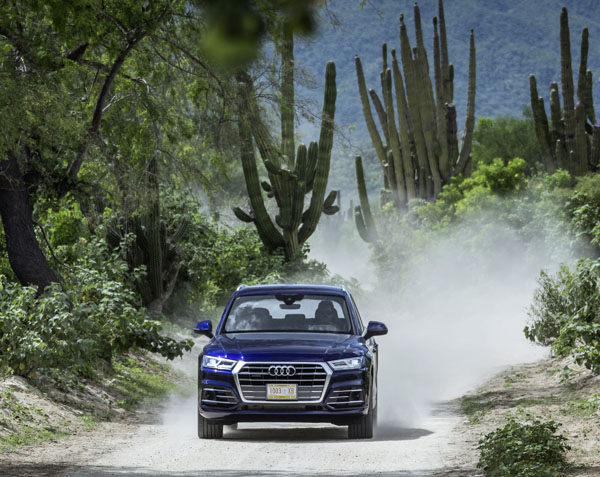
By EWAN KENNEDY in Los Cabos, Mexico
Last week we reported from Mexico the new second generation Audi Q5 in four-cylinder format. That’s because only the four-cylinder models, in turbo-petrol and turbo-diesel format, will initially be on sale in Australia when the first shipments arrived in the second half of 2017.
However, we did manage to get ourselves into the driver’s seat of a V6 as it’s expected to arrive here within a couple of months of the four-cylinder.
It’s an impressive powerplant, the big turbo-diesel produces up to 210 kW of power, with a big 620 Nm of torque from 1500 to 3000 rpm. Torque has already reached its peak at 1500 revs and continues there till it gets to 3000 rpm. Behind the wheel it feels you have an endless supply of grunt just waiting under your right foot. There is a little bit of lag before it gets serious, but once that has passed it’s a great ride.
All Australian Q5s will have automatic transmissions and quattro all-wheel-drive. While the four-cylinder models we tested had part-time versions of Audi’s quattro the turbo-diesel uses permanent AWD as the whole setup is set up to be rugged in the manner of a full-on off-roader. The air suspension system permits changes to ride height on the move with the body able to be raised by as much as 45 millimetres.
We were in Mexico for the global launch because Audi has just completed a modern, high-tech factory there to build the new Q5. We didn’t get a chance to tour the factory, but a close look over the quality of the models built there shows that if anything they are even better built than those from the factory in Germany. That’s because the new-design Q5 is simpler to put together and the quality-control people can follow the assembly of the vehicle on computer screens second by second.
As in the recently introduced Audi Q7, the shape of the front and rear differs with model levels due to specialised bumper bar styling. A clever move from a marketing point of view because it instantly tells others that you’re in a high-grade Audi.
The new Q5 is built on a new platform that takes around 90 kilograms out of its weight. The bonnet and tailgate are of aluminium. Though lighter, the body is stronger than in the first generation model as well as being even better equipped to withstand crashes.
New Audi Q5 is slightly larger than the current one, with a stretch to the wheelbase to give added cabin space in legroom, width and height.
Boot space is minimally larger, up from 540 to 550 litres, it’s easy to load and has a regular shape. Luggage room can be expanded to 1550 litres with the 40/20/40 rear seatbacks folded down. Disappointedly, they don’t fold completely flat to give a really long floor.
Though it’s becoming increasingly common for SUVs never to leave sealed roads Audi insists the new Q5 remains suited to off-road driving. Something we were able to test at the southern corners of the Baja California Peninsula. Our off-road route was chiefly on sandy tracks that were in pretty poor condition.
On sealed roads again the big Audi Q5 V6 is smooth, quiet and comfortable to cruise in. The interior is roomy enough for four adults and a child, with three adults in the back seat being reasonably comfortable.
The Audi MMI infotainment uses a wide 8.3-inch colour screen, or the Virtual Cockpit lets the MMI information be displayed immediately in front of the driver. It can either show large dials when you’re driving in a sporting fashion, or it can show satellite navigation, or trip computer readouts – take your pick. It’s likely the Virtual Cockpit will be standard in some Australian imports and optional in others. It has proven a very popular choice on other recently introduced Audi models.
Australian specifications and prices for the second generation Audi Q5 are yet to be finalised. However, Audi Australia says that despite the additional equipment and technology it would like to keep them to the similar levels as the current models.













